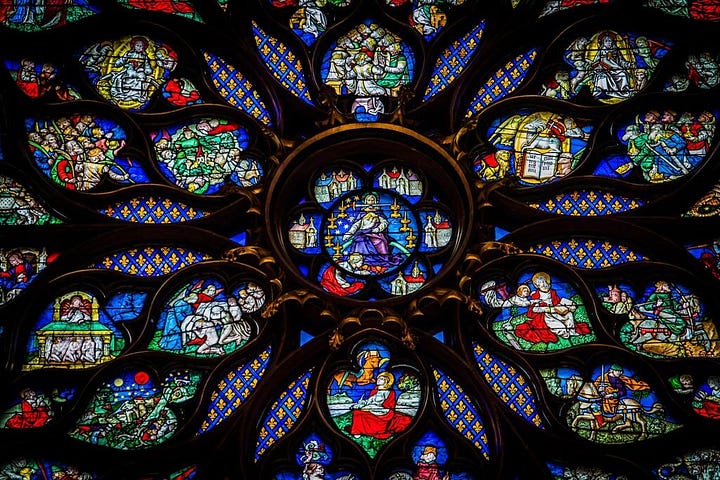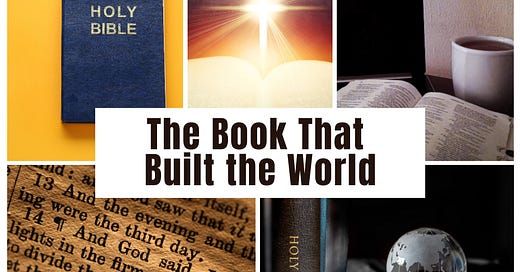A Book of a Thousand Stories and One Great Light - Part Four: The Book That Built the World
Stories That Shape Us: The Power of Narrative in the Bible
(Update: This is the fourth in a quick series on the Bible. I envision six in total. Please comment as you like. And for those who are Free Subscribers, you will love being a Paid Subscriber for this series and for the stories to come later in the summer and the fall. Go here to upgrade your subscription.)
Beyond the Crystal Cathedral
A few weeks ago, I found myself back in Paris. We were there to see our son Daniel and experience the surreal experience of his surreal artistry at Schiaparelli. (Read about those moments here.)
Friends were with us, and we took them, as we often do, to Sainte-Chapelle. It’s just a short walk from Notre-Dame, tickets in hand, worth every penny.
Inside, you don’t just look at stained glass. You stand in it. Over a thousand biblical scenes—Genesis to Revelation—glow above you in color and light. Built in the 13th century under King Louis IX, the chapel is less a cathedral and more a lantern or a lighthouse, flooded with Scripture.
Built under King Louis IX in the 13th century, the place is a small chapel with 70 foot high curtains of stained glass featuring, according to the designers, some 1,127 stories of the Bible.




The building itself is not so much a chapel as it is an echo chamber, echoing a message and retelling it as the eyeball pings against each wall, over and over again. It’s a reminder: this Book isn’t just something to read. It surrounds us.
The Bible Speaks to Itself
I’ve been teaching the Bible for decades. It never runs out. Flip to one part and it pulls you into another. Genesis echoes in Revelation. Psalms whisper in the Gospels. Prophets quote each other without explanation. It’s no loose collection. It’s a living web.
Augustine captured this beautifully: “The New Testament is in the Old Testament concealed,” meaning the Old Testament hints at what’s to come, especially Christ. He also said, “The Old Testament is in the New Testament revealed,” showing that the New fully unveils what was hidden.
Together, these ideas remind us that the Bible is one story—each part waiting to be uncovered through Christ.
But what makes the Bible truly powerful is its stories. They’re not just ancient tales; they’re models for how to live—people to admire, people to critique, lessons wrapped in narrative truth.
These stories are the backbone of our understanding of right, wrong, faith, and failure. They give us concrete examples of human character, divine patience, and divine justice.
That’s one reason the Bible reshaped the West. After the Reformation, the Bible stopped being chained to pulpits and began appearing on nightstands, in home libraries, and on rucksacks. It shaped law, language, ethics, and institutions. Even the idea of the weekend has roots in biblical rhythm.
Most people no longer “read, mark, learn, and inwardly digest” the Bible. But the impact remains. Our world was built with its words. And the stories that influence us today? They’re not just abstract doctrines—they’re models and warnings that echo through the ages.
Stories First, Doctrine Later
The Bible doesn’t give us perfect characters or polished scenes. It gives us humans—awkward, flawed, often unqualified. Moses kills. David abuses power. Peter caves.
Keep reading with a 7-day free trial
Subscribe to The Anglican to keep reading this post and get 7 days of free access to the full post archives.





